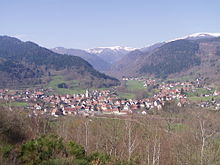Truncated upland

Atruncated upland,truncated highlandorbevelled upland(German:Rumpfgebirge) is the heavilyerodedremains of afold mountainrange, often from an early period inearth history.[1][2]The termRumpfgebirge( "rump mountains" ) was first introduced into the literature in 1886 byFerdinand von Richthofen.[3]The rumps of the former mountain ranges may be found in many lowland regions of theEarth's crust(where they form the so-calledbasement rocks) and especially outcrop in Central Europe through more recenttectonics.This could result in an upliftedpeneplainwhich is one type of truncated upland.
Thevalleystructures of truncated uplands are often more irregular than in the youngerfold mountains,which is due to the considerably youngertectonicprocesses and strongererosionof the formermountain rangesthat were originally often up to several thousand metres high. By contrast, theirplateauxareorographicallysimilar in shape.
Examples
[edit]In western Europe many of theCentral Uplandranges fall into the category of truncated uplands – for example theHarz,theOre Mountains,theFichtel Mountainsand theRhenish Massif.Other ranges also date to the time of theVariscan orogeny,including those on either side of theRhine,such as theBlack ForestandVosgesand, from theBavarian Forestin northeastBavaria,through theBohemian Forestin theCzech Republicto theBohemian MassifinAustriaand the Czech Republic, not to mention the FrenchMassif Central.This mountain formation took place in the MiddlePalaeozoic,during theDevonianandCarboniferousepochs about 350 to 250 million years ago. Already by thePermianthe Variscan mountains had been eroded into the so-called Permian peneplain and overlain bysedimentary strata.These remains survive asVariscan"islands" between the younger sedimentary rocks of theMesozoic.During the course of subsequentearth history,fault blocktectonics followed, which characterised the present appearance of the German Central Uplands. These truncated Variscan mountains are usually strongly affected bymagmaticprocesses.
The erosion of the mountains exposed numerousmineral resourcese.g.silverandiron orein theHarzas well ascopper(theRammelsbergis atype localityforSEDEXdeposits), oruraniumin theOre Mountains.
Even older are theCaledonianMountains ofScotlandand the rest of theplateauxand coastal mountains inScandinavia,which were formed about 500 million years ago.
In North America the almost 3,000-kilometre-longmountain chainof theAppalachiansis one of the largest areas of truncated highland in the world. It extends in widths of 200 to 300 kilometre from thesouthern statesof the United States to the east CanadianNewfoundland,but only reaches heights of just over 2,000 metres in the south. Manymineral depositsof coal,mineral oilandiron ore,as well as fertileplainsmake the range and its surrounding area into one of the richest regions of America.
TheUralsbetween eastern Europe andSiberiahave a similar importance in terms ofminingand the economy; and the extent of these mountains in Russia, which are up to 1,900 metres high, is similar to that of the Appalachians.
References
[edit]- ^Murawski, H., Meyer, W. (2004):Geologisches Wörterbuch.Spektrum Akademischer Verlag, 11th edn., 262 pp.ISBN3-8274-1445-8
- ^Leser, Hartmut, ed. (2005).Wörterbuch Allgemeine Geographie,13th ed., dtv, Munich, p. 778.ISBN978-3-423-03422-7.
- ^Ferdinand von Richthofen (1886),Führer für Forschungsreisende: Anleitung zu Beobachtungen über Gegenstände der physischen Geographie und Geologie(Online)(in German), p. 654
Literature
[edit]- Ferdinand von Richthofen (1886), "II. Rumpfgebirge oder Abrasionsgebirge",Führer für Forschungsreisende: Anleitung zu Beobachtungen über Gegenstände der physischen Geographie und Geologie(Online)(in German), Berlin: Oppenheim, pp. 669–676
